Touring Yangshuo
By admin | August 3, 2010
Sunday, Aug. 1
Yangshuo
Yangshuo is a vacation town. The scenery is straight out of a Chinese watercolor. The Li River runs by, and there are caves and mudbaths and hiking and vanishing tribes shows.
This morning we had western-style breakfast at our hotel—salty scrambled eggs, fake orange juice, and white toast. The Chinese-style breakfast looked better, but I think we’ve been signed up for the other. The directors of our program were really excited about it.
Many teachers were making plans to spend the day together, but Patti and I were not particularly interested in the cat herding project, so we just took off walking to find a bank and get our bearings. We walked probably a mile in the direction we did not think we were going, but we did get sun hats from one of the many roadside vendors. When someone finally helped us figure out where we were on a map, we saw that we were a lot further in the opposite direction than we had hoped to set out, we headed back towards our hotel to go the other way. As we got close, basically in front of a bank with a big orange sign, but where our ATM cards did not work, we decided to rent bikes to cover more ground. There were many corner bike rental places, and tandems are very popular here.
We hadn’t biked in Shenzhen partly because we took a chartered bus back and forth to school every day, and partly because it’s a busy city, and no one follows traffic rules. There are tons of cars, most with relatively new drivers, as well as motorbikes and bicycles zooming everywhere. It was a little sketchy to walk near roads. Here the roads are a little bigger and a little less crowded, and with a lot of people who don’t really know here they’re going. But there’s also tons of tourists riding bikes, so we decided we could do it too. Since they were basically cruiser style bikes, I figured I could captain a tandem reasonably well, and Patti agreed to put her life in my hands. I mean, ride one with me.
The first five minutes were probably the sketchiest. Not because we were getting used to it, but because we immediately encountered the busiest turnabout in probably the whole town. After we didn’t get killed with motorbikes, bikes, buses, trucks and golfcart-style taxis merging from all sides and not necessarily staying on their side of the road, I figured we’d be fine.
We headed out of town in the other direction, where we now believed the Li River to be. We stayed on the main road, and there were many, many Chinese people riding bikes heading that direction too—a good sign! We stopped at a bridge to try to figure out where we were on a map. We had a good view of people on the river going over a small rapids on bamboo rafts. The bridge seemed to be a major in and out spot for this tourist activity. But as we stood there looking at a map, instead of helpful people stopping to see what we needed, two Dutch people stopped to ask us for directions! Because we looked like we knew what we were doing! (We think it must have been our hats.)
We had no idea where the Dragon Bridge they were looking for was, and we just kept going on our main road. Next we came to a parking lot full of tour buses and tandem bikes in front of a small mountain with a huge butterfly statue in front of it. Was this something we should see for 75 yuan (about 10 dollars)? We went to the information window and got a brochure. Only in Chinese. But it looked like a rather involved project, where you followed a rather lengthy path to several different areas, all mysterious to us. And was it uphill? Or through a cave? We decided to give it a pass, as we weren’t ready to make an all-day commitment to a mystery tourist attraction.
We rode on. Though these amazing small, triangular mountains were rising all around us, the road continued to be flat. Next we came to the Big Banyan Tree Natural Scenic Area. Only 20 yuan (3 dollars) and enough signage in English so we had an idea of what we were getting into. One of the top ten scenic attractions in China, the sign told us!
The Banyan tree was big. And there was another opportunity to dress up in Chinese costumes and have our pictures taken. We found out later we chose Miao attire. Even though it was still hot and I was dripping with sweat, I wasn’t going to pass it up this time!
There were also monkeys in adorable monkey suits with which to be photographed. Ethically questionable, but cute. We sat for the pictures. There is not much about traveling in China that is not either ethically questionable or the very least unsafe to an American mindset. From no bike or motorcycle helmets or adherence to the appropriate side of the road to lack of free speech rights to our Chinese teachers being expected to supervise children from 8 to 5 with no actual breaks, there could be something to object to at every turn. As a first time visitor to China who did not manage to do even the most cursory research into what I might experience here before I arrived, I think the best role for me here at the moment is that of a polite guest, rather than a conscientious objector. Even now I do not feel I have collected enough information to make a really informed opinion about this culture.
Then there is also the quandary of wondering if I want to visit certain places here in Yangshuo or not because they are too “touristy.” Well, I am a tourist. And even though there are parts of this town that could remind you of a place like Ybor City in Tampa or even Garnet St. in PB, it’s all new to me. Is it tacky, or not the most accurate representation of Chinese culture? Maybe, but it’s hard for me to make that distinction. I can mostly tell if some places are more crowded than others.
Also at the Banyan tree area were bamboo rafts. After watching for a while, we determined that you get to paddle them yourselves! Once we got out on the water, we realized we were in a blocked off part of the river, like a kiddie pool. Good thing. The long bamboo poles were tricky to maneuver. We couldn’t quite figure out if it was more effective to push off the bottom or paddle more like a canoe. Most of the Chinese families floating around seemed to not be much better at it than Patti and I, though for the most part we were able to avoid colliding. One time we used our poles to push a family’s boat away from ours, so we wouldn’t crash, as we all smiled and waved good-naturedly at each other.
Though we had been warned repeatedly against “street food”, we got a fried cake and a leaf-wrapped sticky rice from a vendor. Both were tasty and neither of us got sick. We’re all avoiding the tap water, as it seems to be common practice to boil it first. (And we’re going through what at home I would find to be an unconscionable amount of plastic bottles. Ugh.) There are also many other safety warnings posted in our hotel. While I’m not going to leave my laptop sitting in the lobby, danger from the Chinese people seems less than minimal. When we tried to leave the hotel housekeeping staff a tip at our last hotel, they chased us down the hall, concerned we had left some money in the room.
So we rode on from the Banyan Tree on the tandem, nominally heading for a café that had a big English billboard that we’d passed earlier. As far as we could tell, it was at the foot of Moon Hill, a hill with a big arch at the top that had been recommended to me by one of our Chinese teachers. At the café, they offered Western-style food, and also “farmer food,” which referred to more local fare. I might have called it Chinese food. We chose a combination of both—mango milkshakes and pumpkin chips, both delicious! We did not eat the snake, nor drink its blood.
After lunching among large groups of Dutch and Australian tourists, we set off to hike up the hill. On the road, we had been momentarily surrounded and then passed by a several groups of non-Asians following guides, and we felt pretty proud of ourselves for having such a great tour without the need of our own guide. (As everything was right on the one main road, it wasn’t that dramatic of an accomplishment. But many people did not attempt it.) At the gate to Moon Hill, we ran into Susan from our group on her way down. She had started out with Ann, who didn’t feel well and turned back. But Susan was having a terrific time being out on her own. Sticking with the group (or more accurately waiting around for the group) can get awfully tiring. She advised us to stay to the left, and be sure to follow the steps past the arch when you think you’re at the top for a better view.
More steps was not what I necessarily needed the day after hiking up the 2,000 steps of Nan Shan in Shenzhen, but it was the only to get there. We went up through the bamboo forest surrounded by very noisy insects and followed by an old Chinese woman trying to sell us postcards and water. The formation looked very much like those at Arches National Park in Utah, if it were a green jungle rather than a desert, and it was made out of dripping clay rather than slickrock. Patti and I wondered what the story behind the name Moon Hill was. Was it from the shape of the cutout of the arch, or a fairytale, or what? We were also very excited to get some information from the internet about how these amazing mountains were formed. Where is an English-speaking geologist when you need one!
After this full day, we tandemed back to the hotel. It was so much quicker returning than it had been going, once we knew where we were! Patti online long enough to get a synopsis of the story of the performance we were going to see that night. Then we lost the internet connection. Still no geology information!
So our whole group boarded a bus to head to this performance that is famous for the town. We heard it was performed on the river, with boats, fire, and over 600 performers. This being China, they couldn’t just hand us all tickets. We were supposed to stay in a group from the bus to the theater, and be led to our seats by a woman holding a long stick with a stuffed animal on the end. With our group of Americans, we barely made it in. On the one hand, the rugged individualist American mindset seems to make this type of activity more difficult. On the other hand, it made feel awfully proud of the students at Xara who spent a lot of time discussing whether things worked for them, and noticing that things that work for one person don’t always work for the group, and how to problem solve around those issues.
The performance was big, but not tremendously compelling, especially after a long day in the sun. The theater could hold up to 10,000 people, and seemed to be about half full. The show didn’t seem to follow the storyline Patti had looked up, about the third sister who was kidnapped by a warlord and rescued by her sisters and her lover. But there were some very impressive effects with light up suits causing large numbers of people to appear and disappear very suddenly. They weren’t even spinning the fire, just holding torches. There was a very cool effect with red fabric and people on boats, but we couldn’t tell what it was supposed to mean, narrative-wise. Maybe the warlord marching through, leaving bloodshed in his wake. But it didn’t seem like it.
What a fun day! And there was still a lot to do in Yangshuo, but I was also starting to remember that, sometimes, on vacation, you just need to rest.

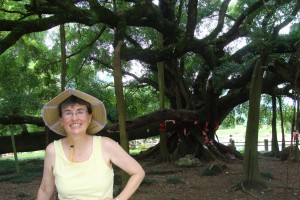
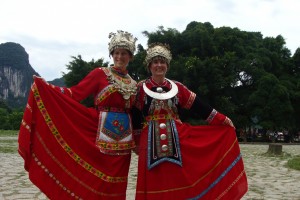
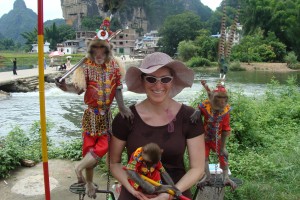
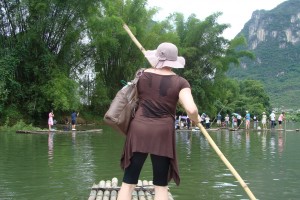
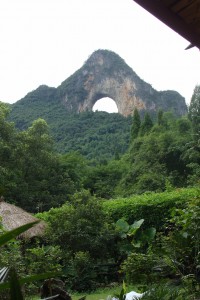
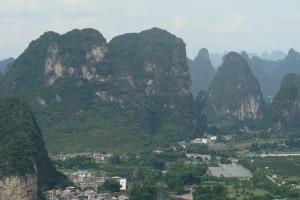
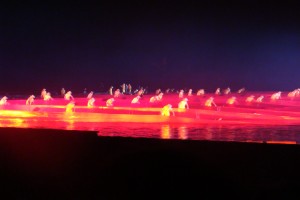
Leave Your Comment